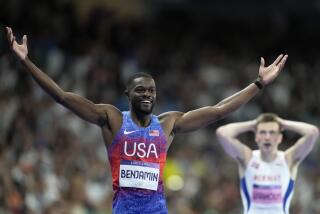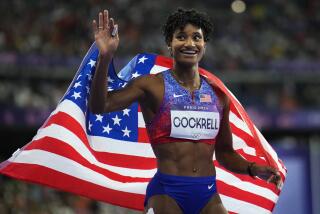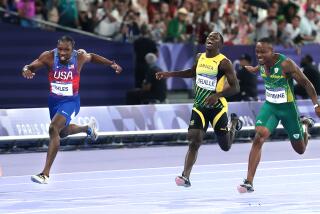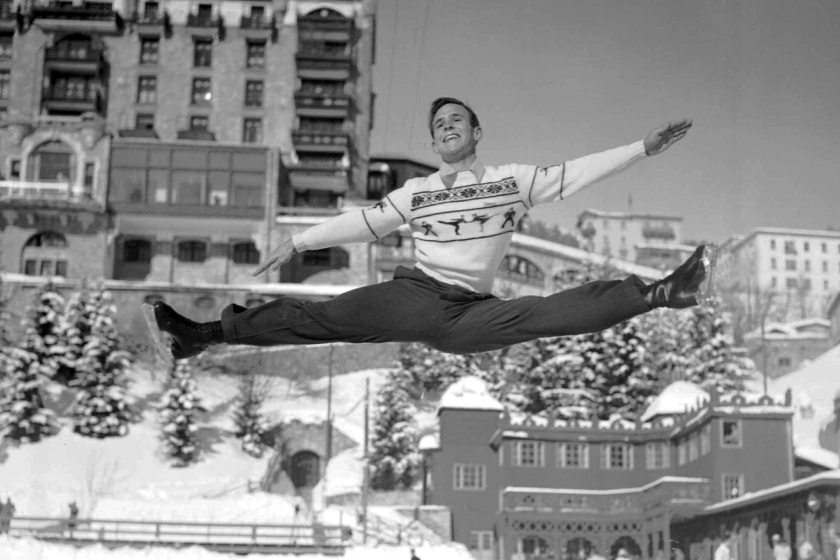Griffith-Joyner Is No Fluke : She Wins in 10.61; Moses Impressive in Hurdles
- Share via
INDIANAPOLIS — Wonders didn’t necessarily cease at the U.S. Olympic track and field trials Sunday, but the wind and everything else, including the furor over Florence Griffith-Joyner’s times and her outfits was more subdued than it had been the day before.
It was a day for respecting elders, which those who compete against Edwin Moses, 33, and Mary Decker Slaney, 29, have no choice but to do.
Moses earned a place on his fourth Olympic team, winning the 400-meter intermediate hurdles in 47.37, the seventh-best performance of all-time and the best of 1988. Slaney made her third Olympic team, winning the 3,000 meters in 8:42.53, the fourth-best time in the world this year.
As for Griffith-Joyner, all she did was run 10.70 in a semifinal heat of the 100 meters and then win the final two hours later in 10.61, which are the second- and third-best times ever run by a woman.
Twenty-four hours earlier, that would have been very impressive indeed. But after the 10.49 she ran in a quarterfinal heat Saturday, breaking Evelyn Ashford’s previous world record of 10.76 by almost three-tenths of a second, the crowd of 11,904 at Indiana-Purdue University Stadium almost yawned through these races.
But her times Sunday confirmed that Griffith-Joyner, a Los Angeles native who lives in Van Nuys and trains with the World Class Athletic Club at UCLA, has become, at 28, the world’s fastest woman.
Unlike Saturday, there was no question that her times in the semifinals and final were run with prevailing winds under the 2.0 meters per second allowable for record consideration. On a relatively calm day, the wind gauge registered 1.6 for her first race and 1.2 for her second.
What can she do for an encore, other than design even flashier outfits for herself? She wore all black in the first race Sunday, coming back with a shimmering blue bodysuit in the second that covered one leg and left the other bare.
She begins competition in the 200 meters Friday.
Asked if he still considers that her best event, her coach, Bob Kersee, said: “I guess we’ll find out. If I have to buy a ticket to see it, I will.”
Meantime, the two women who joined Griffith-Joyner on the Olympic team in the 100 meters reacted differently to having 10.49 as the standard in their event.
Ashford, the defending Olympic champion whose 10.81 in the final Sunday is tied for the sixth-fastest of all-time, said she, at 31, looks forward to the challenge.
“It’s given me motivation for the future,” said Ashford, who, like Griffith-Joyner, went to UCLA and now lives in Walnut.
But Gwen Torrence, who finished third at 10.91 and is the baby of the group at 23, said she doesn’t believe she will ever hold the world record.
“That 10.49 is so incredibly fast, I don’t believe it will be broken for decades,” said Torrence, who graduated last year from the University of Georgia. “I think we can look at 10.76 or 10.79. But I don’t think the 10.49 is approachable.”
There were numerous track and field experts who believed Moses, a Dayton, Ohio, native who now lives in Laguna Beach, not only was approachable in this competition but beatable. He lost in the intermediate hurdles last year for the first time in almost 10 years and then fell in a subsequent race. Although he later won the World Championship, he did it by the narrowest of margins.
It appeared before Sunday that three other Californians, Andre Phillips of San Jose, Danny Harris of Perris and Kevin Young of Los Angeles, would challenge him and perhaps even prevent him from earning a berth on the three-man Olympic team. None of them came close.
Moses, as he has done so many times before, started fast, moved into the lead between the sixth and seventh of the 10 hurdles, and coasted to his 173rd victory in 181 races since 1975. His record since Aug. 26, 1977, is 143-2.
Phillips, who finished at UCLA in 1981, and Young, who, if he can pass a sociology test Tuesday, will be closer to finishing at UCLA, also made the Olympic team in a very tight race that saw the first five run under 48 seconds. Never has that happened before.
Disappointed in his last two attempts to earn places on the Olympic team, Phillips was clearly second in 47.58. But judges had to look at a photo before they could determine that Young was third in 47.72.
Immediately after crossing the finish line, David Patrick was handed a tiny American flag by an official and told to take a victory lap. But as he rounded the last curve, he heard the public-address announcer say that Patrick had been beaten for third place by Young. Patrick’s time was 47.75, just ahead of Harris’ 47.76.
Asked if believed he had proved anything by once more holding off the pack, Moses said: “I proved that when you’re 33 years old you can still run. Age isn’t a factor.
“I feel better than I’ve felt in years, going back to the early ‘80s. I still feel I haven’t peaked. It looks like this year might be the year I go under 47 seconds.”
Unlike Moses, Slaney wasn’t anticipating a challenge. She got one in the 3,000 meters when Vicki Huber, a Villanova junior, caught her with 800 meters remaining and matched her stride-for-stride until the final lap.
Slaney finally pulled away in the final 400 meters, but Huber was still able to set a National Collegiate Athletic Assn. record at 8:46.48.
“I’ve run this year, but this is the first time I’ve raced,” Slaney said. “I’m surprised she challenged me, but I’m really happy about it. When you’re running from the front by yourself, you don’t apply yourself.”
Huber said he considered attempting to pass Slaney.
“But that thought didn’t even last a second,” she said. “I thought the best thing was to save my energy and go for second.”
The real battle was for third place between PattiSue Plumer, formerly of Stanford, and Sabrina Dornhoefer, formerly of the University of Missouri. With about 300 meters remaining, they pulled away from 1987 national champion Mary Knisely of Dallas and ran shoulder-to-shoulder until, seven meters from the finish line, Dornhoefer fell.
She got back on her feet and finished fourth in 8:57.63, more than eight seconds behind Plumer’s 8:49.21. Both collapsed at the finish line and had to be transported to the medical tent.
While Slaney and Huber took their victory lap, Plumer, flat on her back in the emergency cart, waved to the crowd. She and Dornhoefer were released about an hour later, having been re-hydrated.
Slaney criticized U.S. officials for scheduling the start of the 3,000 at 3:45 p.m. At that time, the temperature was 95 degrees and the heat index was 100.
“In the future, the organizers should think about moving the distance races until after the sun goes down, if the meet is in a climate like this,” she said.
The final group selected Sunday was in the men’s javelin, in which Dave Stephens, formerly of Cal State Northridge, won with a throw of 261 feet 4 inches on the last of his six throws. Brian Crouser, formerly of the University of Oregon, finished second (260-8), and Tom Petranoff of Oceanside finished third (260-8).
More to Read
Go beyond the scoreboard
Get the latest on L.A.'s teams in the daily Sports Report newsletter.
You may occasionally receive promotional content from the Los Angeles Times.






